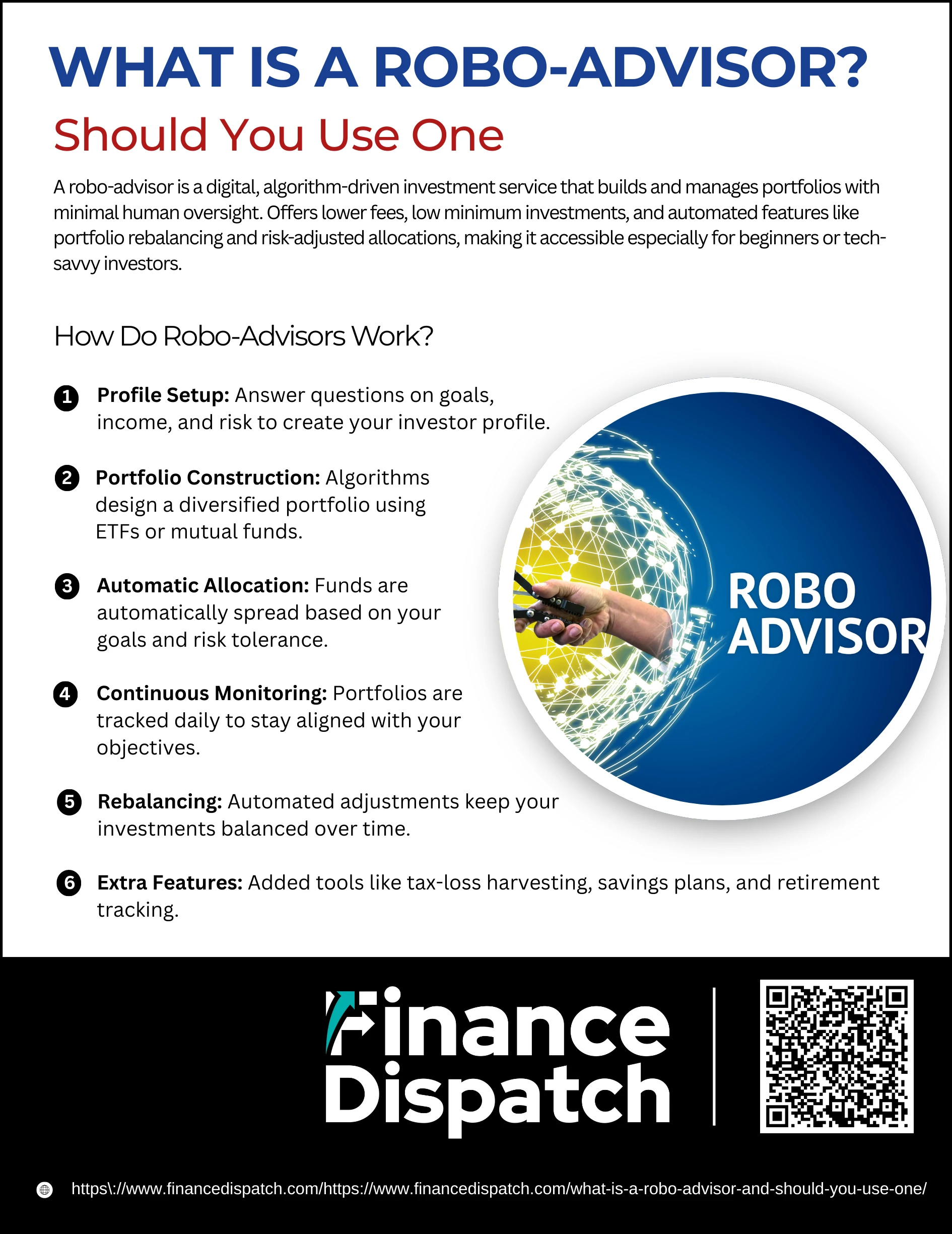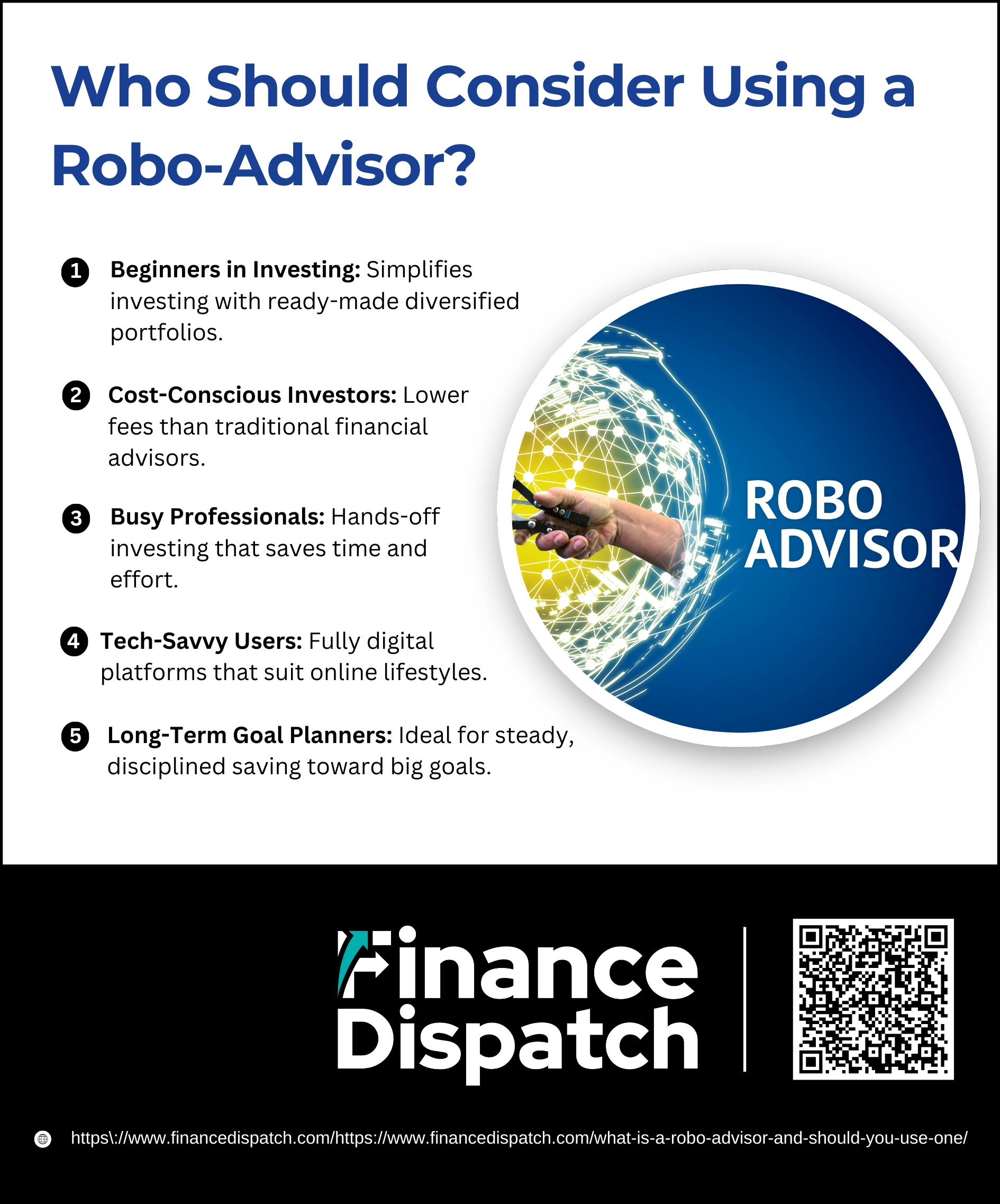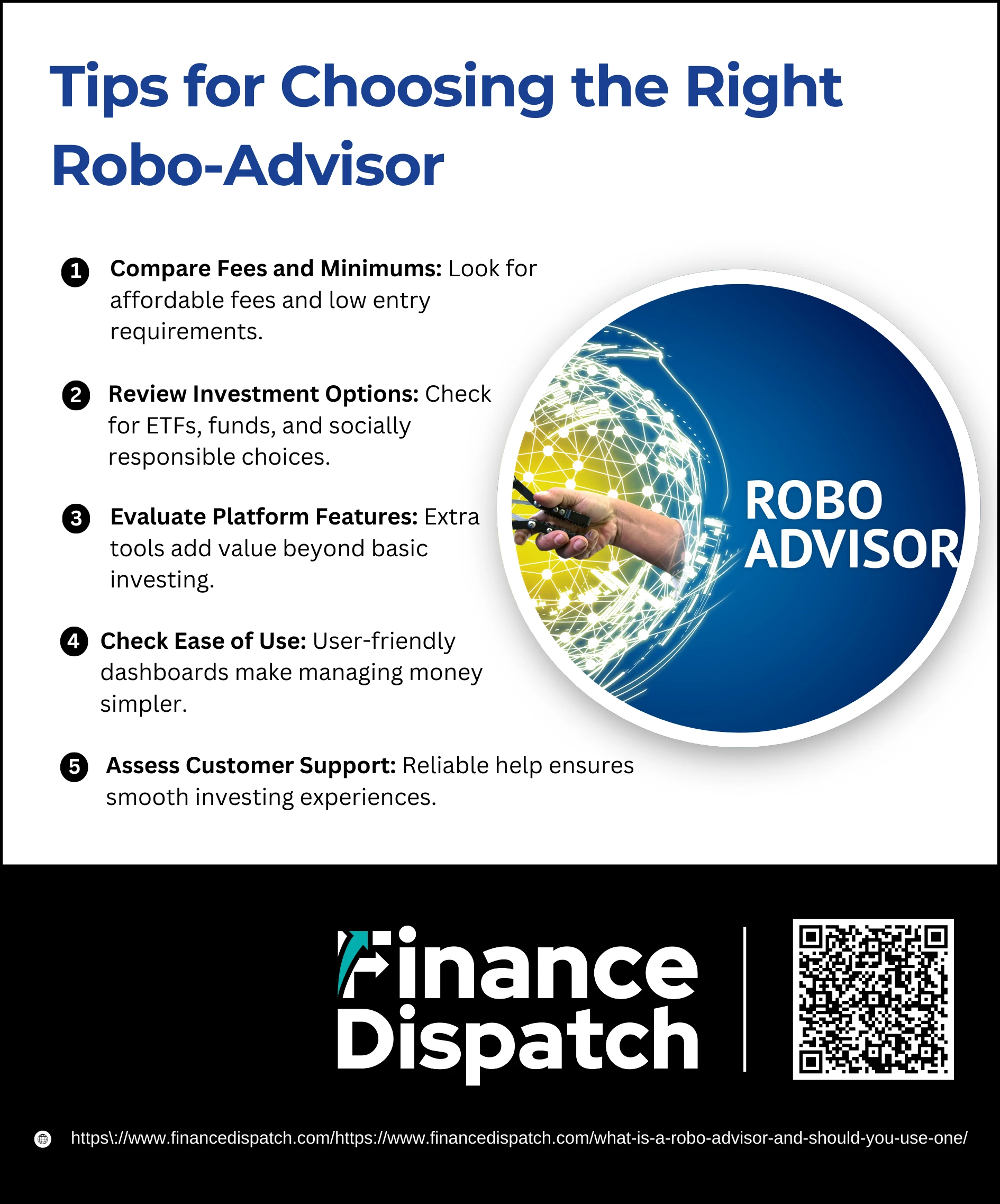If you’ve ever wondered whether investing can be as simple as setting up an app on your phone, you’re not alone. Robo-advisors have quickly grown in popularity as a low-cost, automated way to manage investments without needing to meet face-to-face with a financial planner. These digital platforms use algorithms to build and adjust portfolios based on your goals and risk tolerance, making them especially appealing to beginners and busy investors. But convenience isn’t everything—before deciding if a robo-advisor is right for you, it’s important to understand what they are, how they work, and whether their benefits outweigh their limitations for your personal financial situation.
What is a Robo-Advisor?
A robo-advisor is an online investment platform that uses computer algorithms to manage your money automatically. Instead of sitting down with a traditional financial planner, you answer a few questions about your goals, timeline, and comfort with risk, and the robo-advisor builds a portfolio that matches your profile. Most platforms rely on low-cost exchange-traded funds (ETFs) and regularly rebalance your investments to keep you on track. The idea is to make professional-style money management simple, affordable, and accessible to anyone—even if you’re just starting with a small amount to invest.
 How Do Robo-Advisors Work?
How Do Robo-Advisors Work?
Robo-advisors streamline investing by automating tasks that would normally require a human advisor. They rely on advanced algorithms to assess your situation, choose the right mix of investments, and keep your portfolio balanced over time. Here’s how the process typically works:
1. Profile Setup
You start by creating an account and answering a short questionnaire. This covers details like your age, income, financial goals (e.g., retirement, buying a home), investment horizon, and risk tolerance. These answers help the robo-advisor understand what type of investor you are.
2. Portfolio Construction
Using your profile, the robo-advisor designs a portfolio made up of exchange-traded funds (ETFs) or mutual funds. These are chosen to provide diversification across different asset classes—such as stocks, bonds, or real estate—so your money isn’t concentrated in one area.
3. Automatic Allocation
Once your portfolio is built, your money is automatically spread across the chosen investments. The allocation is based on your goals and risk level—for instance, a younger investor may have a higher percentage in stocks, while someone closer to retirement might see more bonds for stability.
4. Continuous Monitoring
Unlike traditional investing where you might check in occasionally, robo-advisors monitor your portfolio daily. They track how each investment performs and ensure your portfolio remains aligned with your original goals.
5. Rebalancing
Over time, market movements can throw your portfolio off balance—for example, if stocks grow faster than bonds, you may end up with more risk than intended. Robo-advisors automatically rebalance by selling some assets and buying others, keeping your portfolio aligned with your target mix.
6. Extra Features
Many robo-advisors go beyond simple portfolio management. Some offer tax-loss harvesting (selling losing investments to offset taxable gains), retirement goal tracking, automatic savings plans, or even hybrid models with access to human advisors for more complex needs.
Key Benefits of Using a Robo-Advisor
Robo-advisors have become popular because they make investing simple, affordable, and accessible. Whether you’re just getting started or looking for a hands-off way to grow your money, these platforms offer several advantages that can help you stay on track with your financial goals.
1. Low Fees: Robo-advisors usually charge much less than traditional financial advisors, making them cost-effective for all types of investors.
2. Accessibility: You don’t need a large amount of money to start; many platforms have low or no minimum investment requirements.
3. Convenience: The entire process is managed online, giving you 24/7 access and the ability to invest without scheduling appointments.
4. Automated Portfolio Management: Your investments are continuously monitored and rebalanced to match your goals and risk level.
5. Diversification: Portfolios are built with a mix of asset classes, helping reduce risk while aiming for steady growth.
6. Goal-Oriented Tools: Many robo-advisors include features like retirement calculators and savings trackers to keep you focused.
7. Potential Drawbacks and Limitations of Robo-Advisor
While robo-advisors make investing easier and more affordable, they aren’t a perfect fit for everyone. Depending on your financial situation and preferences, the lack of personalization or reliance on technology may feel limiting. It’s important to weigh these drawbacks before deciding if a robo-advisor is the right choice for you.
1. Limited Human Interaction: You won’t get the personalized guidance, emotional support, or financial coaching that a human advisor can provide.
2. Less Tailored Advice: Robo-advisors typically use standard models, which may not address complex financial needs like estate planning or tax strategy.
3. Reliance on Technology: Since they are fully digital platforms, issues like outages, glitches, or cybersecurity risks can affect your access or trust.
4. Narrow Service Range: Most robo-advisors focus on investment management and may not offer comprehensive financial planning services.
5. One-Size-Fits-All Approach: If your financial goals are highly unique, the standardized investment strategies may feel restrictive.
Robo-Advisor vs. Human Financial Advisor
When deciding how to manage your investments, one of the biggest questions is whether to rely on technology or a traditional human advisor. Robo-advisors provide affordable, automated solutions, while human advisors offer personal guidance and in-depth planning. Comparing the two side by side can help you see which option better fits your needs.
| Feature | Robo-Advisor | Human Financial Advisor |
| Cost | Low fees, typically 0.25–0.50% of assets | Higher fees, often 1% of assets or more |
| Personalization | Standardized, algorithm-based advice | Highly customized to individual goals |
| Accessibility | 24/7 online access via apps and websites | Appointment-based, limited by availability |
| Convenience | Fully automated portfolio management | Manual planning with client input |
| Human Guidance | None, purely digital support | Provides emotional support and tailored coaching |
| Complex Needs | May not address tax planning, estate planning, or business finances | Capable of handling complex financial strategies |
 Who Should Consider Using a Robo-Advisor?
Who Should Consider Using a Robo-Advisor?
Robo-advisors aren’t designed for everyone, but they can be a smart fit for certain types of investors. If you value convenience, affordability, and a hands-off approach to managing your money, these platforms may align well with your needs. Here are the kinds of people who benefit most:
1. Beginners in Investing
If you’re new to investing, the idea of picking stocks, bonds, or funds on your own can feel overwhelming. Robo-advisors simplify this by creating a diversified portfolio for you based on your goals and risk level. This helps you start investing without needing deep financial knowledge.
2. Cost-Conscious Investors
Traditional financial advisors often charge around 1% of your assets under management, which can eat into returns over time. In contrast, robo-advisors typically charge between 0.25–0.50%, making them a more affordable option for investors who want professional-style management without high fees.
3. Busy Professionals
Many people don’t have the time to research investments, rebalance portfolios, or monitor markets. For those juggling work and personal responsibilities, robo-advisors offer a hands-off solution where the system takes care of the heavy lifting, freeing up time while still keeping investments on track.
4. Tech-Savvy Users
Since robo-advisors operate entirely online, they are a natural fit for those comfortable using apps and digital platforms. If you like managing your banking, shopping, and daily tasks digitally, using a robo-advisor will feel familiar and convenient.
5. Long-Term Goal Planners
Robo-advisors are designed for goals that require consistency and discipline, such as retirement savings, buying a home, or building a college fund. Their automated rebalancing and steady approach to investing make them well-suited for people who want to stay the course without frequent tinkering.
 Tips for Choosing the Right Robo-Advisor
Tips for Choosing the Right Robo-Advisor
Not all robo-advisors are built the same, and picking the right one can make a big difference in your investing experience. Here are some key things to look out for before signing up:
1. Compare Fees and Minimums
Every robo-advisor charges a management fee, usually expressed as a percentage of your assets. While most range from 0.25% to 0.50%, even small differences can add up over time. Also, pay attention to account minimums—some platforms let you start with as little as $5, while others may require thousands of dollars to open an account.
2. Review Investment Options
Look closely at the types of investments each platform offers. Many robo-advisors build portfolios using low-cost exchange-traded funds (ETFs), but the selection can vary. If socially responsible or sustainable investing is important to you, check whether the platform provides those options.
3. Evaluate Platform Features
Beyond basic investing, the added features can be a big plus. Some robo-advisors include tax-loss harvesting to help reduce your tax bill, retirement planning calculators, or automatic savings tools. These extras can provide more value and help align your investing with your long-term goals.
4. Check Ease of Use
Since you’ll be managing everything online, a smooth and intuitive interface matters. A simple dashboard that clearly shows your portfolio’s performance makes it easier to stay engaged. If the app feels clunky or confusing, you may find it frustrating to use over time.
5. Assess Customer Support
Even with automation, there will be times when you need help—whether that’s a technical issue, a question about your account, or clarity on how the service works. Strong customer support through phone, chat, or email ensures you won’t feel stranded if problems arise.
Conclusion
Robo-advisors have opened the door for anyone to invest with confidence, offering an affordable and automated way to grow wealth over time. They provide convenience, low fees, and hands-off management, making them a strong choice for beginners, busy professionals, and cost-conscious investors. Still, they aren’t a one-size-fits-all solution—those with complex financial needs or a preference for personal guidance may find more value in working with a human advisor. Ultimately, the decision comes down to your goals, comfort with technology, and how much support you want along your financial journey.



